Removal Procedure
- Remove the fuel tank filler cap in order to release the fuel vapor
pressure in the fuel tank. After releasing the pressure, reinstall the filler
cap.
- Release the fuel pressure. Refer to
Fuel Pressure Relief
in Engine Controls.
Caution: Unless directed otherwise, the ignition and start switch must be in the OFF or LOCK position, and all electrical loads must be OFF before servicing
any electrical component. Disconnect the negative battery cable to prevent an electrical spark should a tool or equipment come in contact with an exposed electrical terminal. Failure to follow these precautions may result in personal injury and/or damage to
the vehicle or its components.
- Disconnect
the negative battery cable.
- Drain the cooling system. Refer to
Cooling System Draining and Filling
in Engine Cooling.
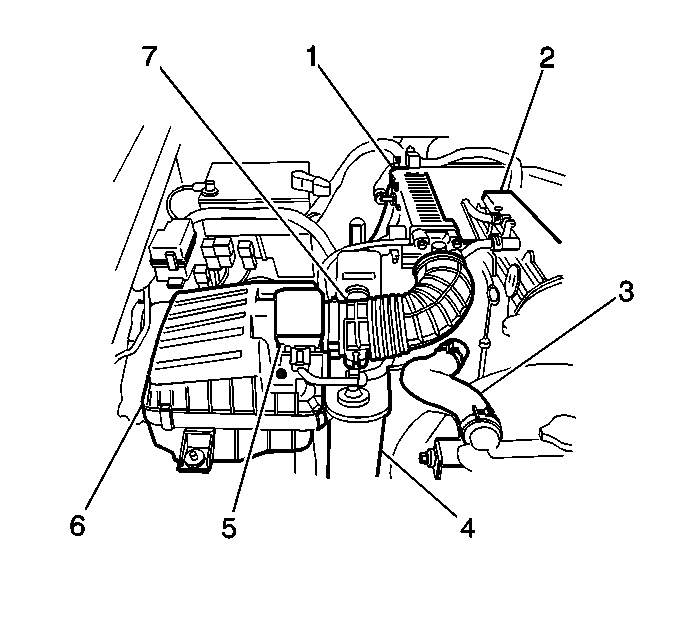
- Disconnect the intake
air temperature (IAT) sensor.
- Disconnect the mass air flow (MAF) sensor.
- Depress the electrical harness clamps and remove the harness from
the air cleaner assembly.
- Remove the air intake hose (7) from the throttle body.

- Remove the accelerator
cable (2) from the accelerator cable bracket (1).
- Remove the accelerator cable from the throttle body bellcrank (3).
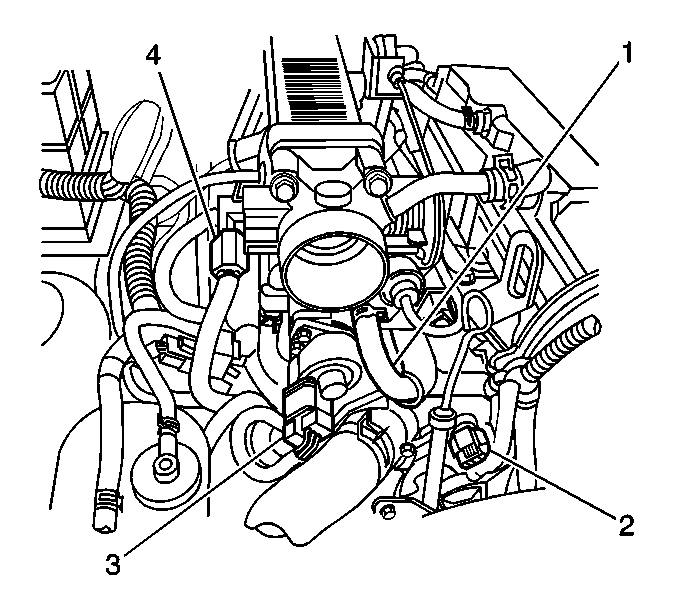
- Disconnect the following
electrical connectors:
| • | Throttle position (TP) sensor (4) |
| • | Idle air control (IAC) valve (3) |
| • | Engine coolant temperature (ECT) sensor (2) |
| • | Evaporative emission canister purge valve |
- Remove the EVAP canister purge valve vacuum hose.
- Remove the EVAP canister purge valve bracket bolt.
- Remove the EVAP canister purge valve bracket and valve assembly.
- Remove the coolant hose from the throttle body (1).
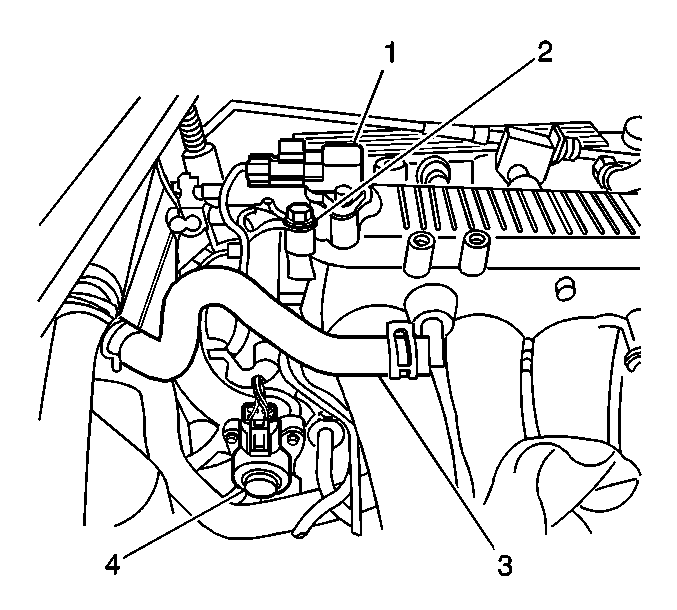
- Disconnect the following
electrical connectors:
| • | Exhaust gas recirculation (EGR) connector (4) |
| • | Manifold absolute pressure (MAP) sensor connector (1) |
| • | Engine ground wire (2) from intake manifold |
- Remove the brake booster supply hose (3) from the intake
manifold.
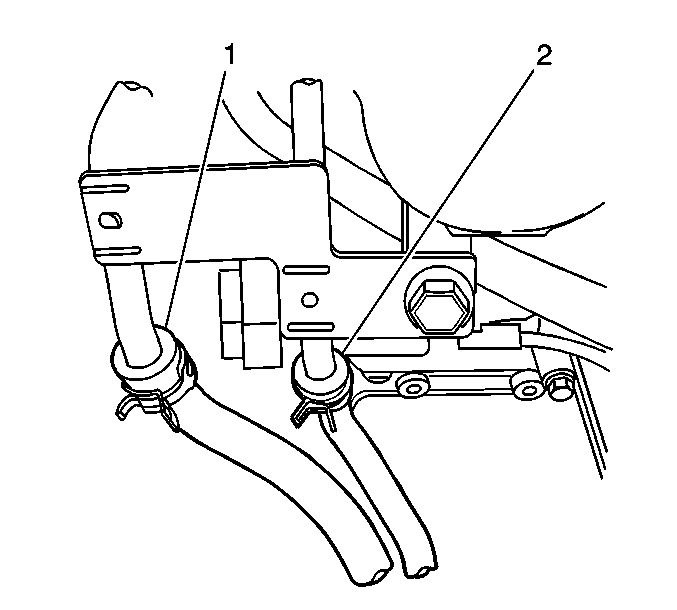
Important: Use a shop rag to catch any fuel that may leak during the disconnection
of the fuel lines.
- Disconnect the inlet fuel line (1).
- Disconnect the return fuel line (2).

- Remove the upper radiator
hose from the thermostat housing (1).
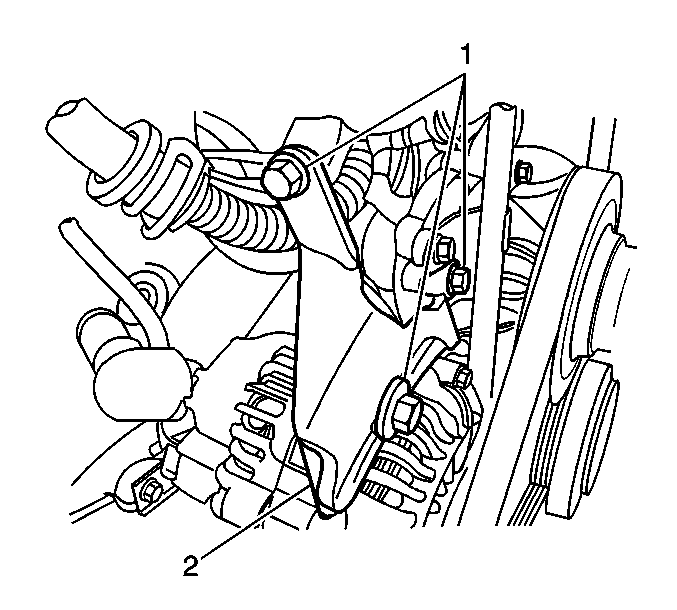
- Remove the upper generator
mounting bracket (2).
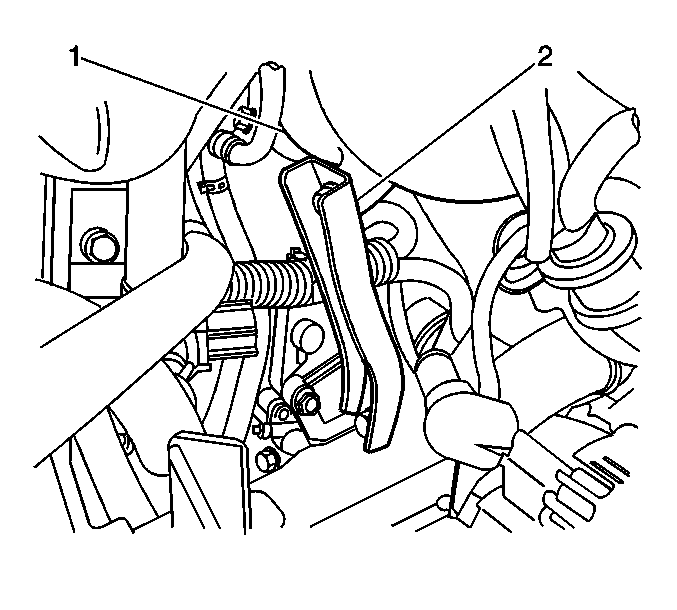
- Remove the lower intake
manifold support bracket (2) from the intake manifold (1).
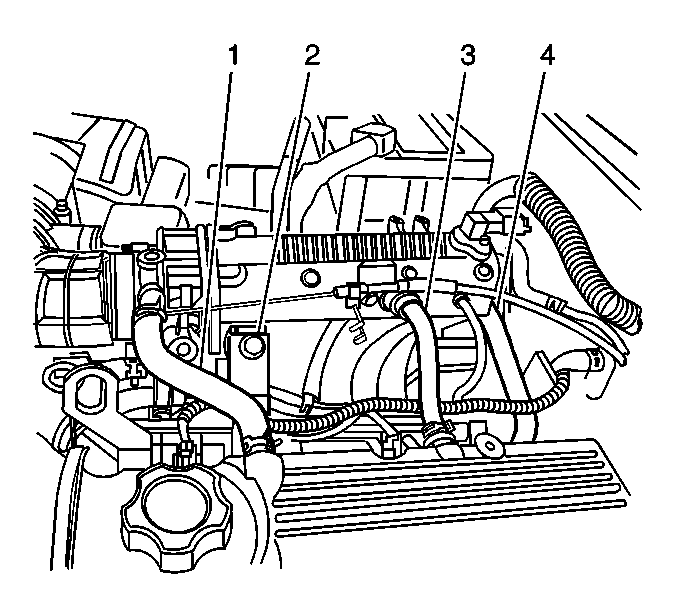
- Remove the crankcase vent
hose (1).
- Remove the PCV hose from the PCV valve (3).
- Disconnect the fuel injector 6-way connector at the rear
of the intake manifold.
- Remove the EGR valve.
- Disconnect the heated oxygen sensor (HO2S1) electrical connector.
- Raise and suitably support the vehicle. Refer to
Lifting and Jacking the Vehicle
in General Information.
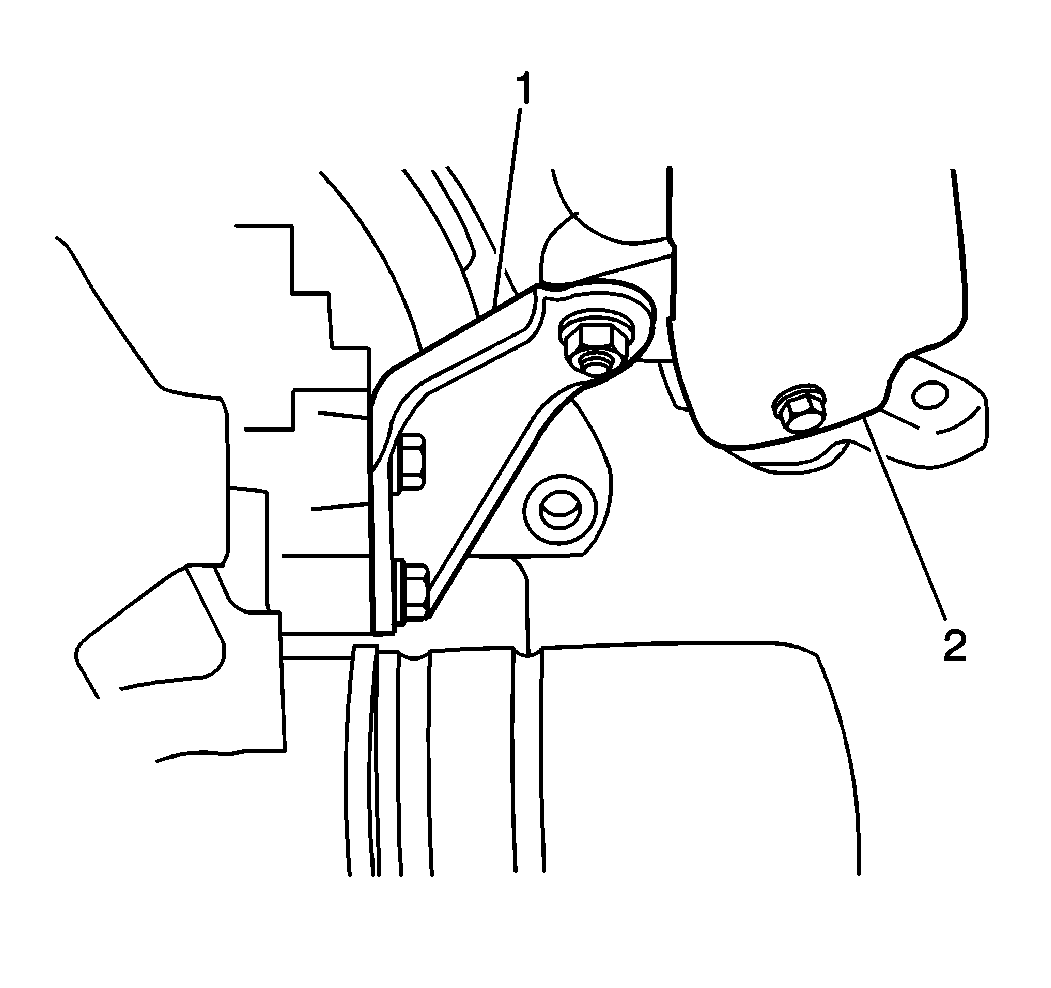
- Remove the following from
the exhaust manifold and engine block:
| • | The exhaust manifold reinforcement bracket (1) |
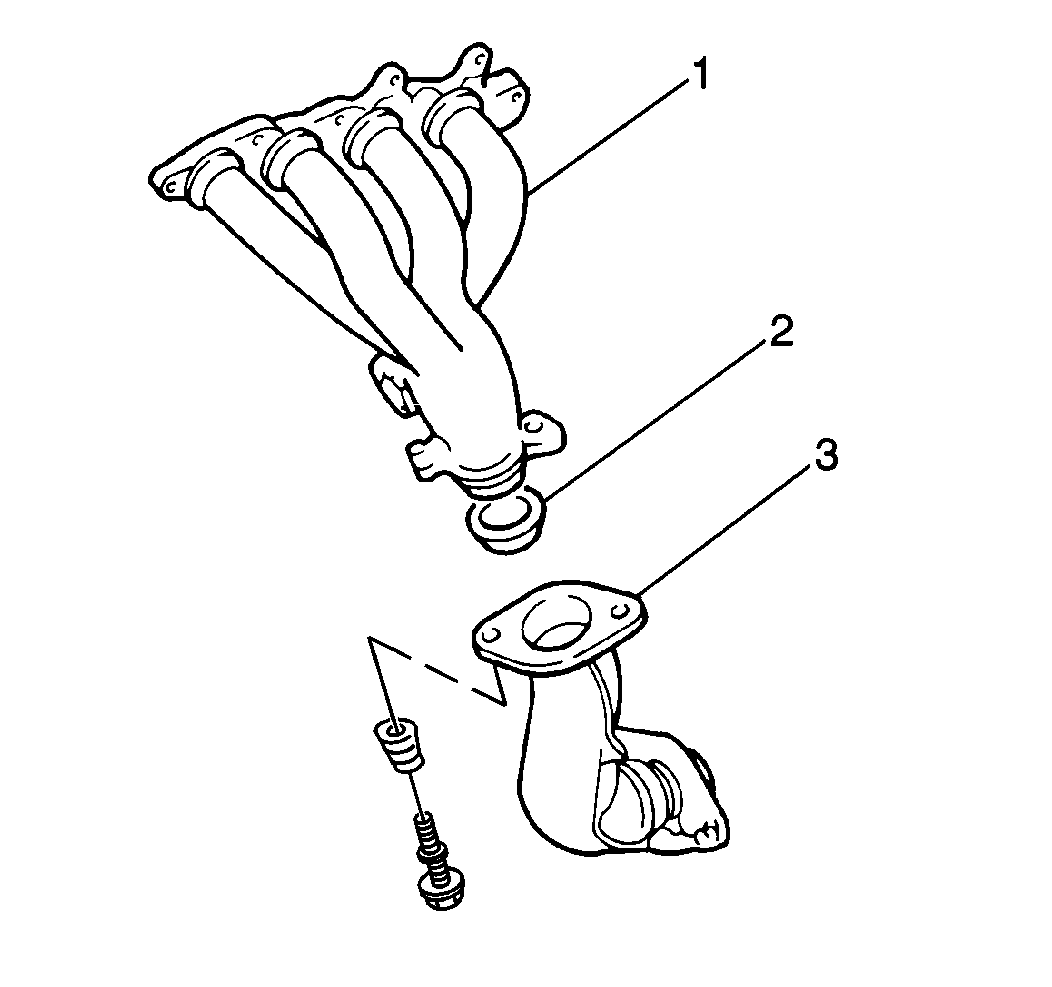
- Remove the following from
the exhaust manifold (1):
| • | The front pipe/three way catalytic converter (TWC) assembly (3) |
- Lower the vehicle.
- Remove the valve rocker arm cover. Refer to
Valve Rocker Arm Cover Replacement
.
- Remove the timing belt. Refer to
Timing Belt Replacement
.
- Remove the camshaft. Refer to
Camshaft Replacement
.

Important: Loosen the cylinder head bolts gradually in the specified sequence to
prevent the cylinder head distortion.
- Remove the cylinder head bolts from the cylinder block.
- Remove the cylinder head, intake manifold, and exhaust manifold
as an assembly.
- Clean the mating surfaces of the following:
- Clean all the bolt threads and bolts.
- Inspect the cylinder head. Refer to
Cylinder Head Cleaning and Inspection
.
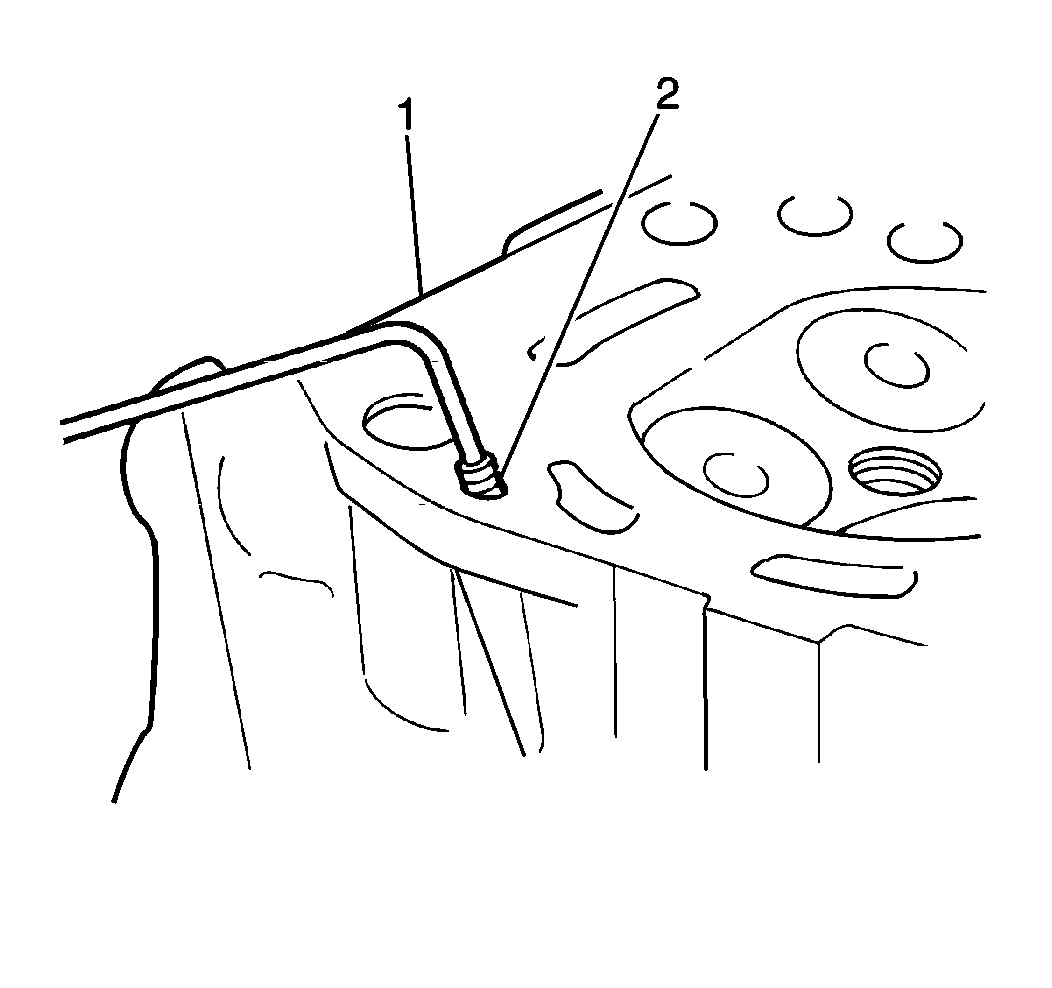
Notice: Use the correct fastener in the correct location. Replacement fasteners
must be the correct part number for that application. Fasteners requiring
replacement or fasteners requiring the use of thread locking compound or sealant
are identified in the service procedure. Do not use paints, lubricants, or
corrosion inhibitors on fasteners or fastener joint surfaces unless specified.
These coatings affect fastener torque and joint clamping force and may damage
the fastener. Use the correct tightening sequence and specifications when
installing fasteners in order to avoid damage to parts and systems.
- Inspect the oil
jet (2) in the cylinder head for any obstructions and ensure that the
oil jet is tightened to its torque specification.
Tighten
Tighten the oil jet to 5 N·m (44 lb in).
Installation Procedure
- Apply clean engine oil to the threaded portion of all of the cylinder
bolts.
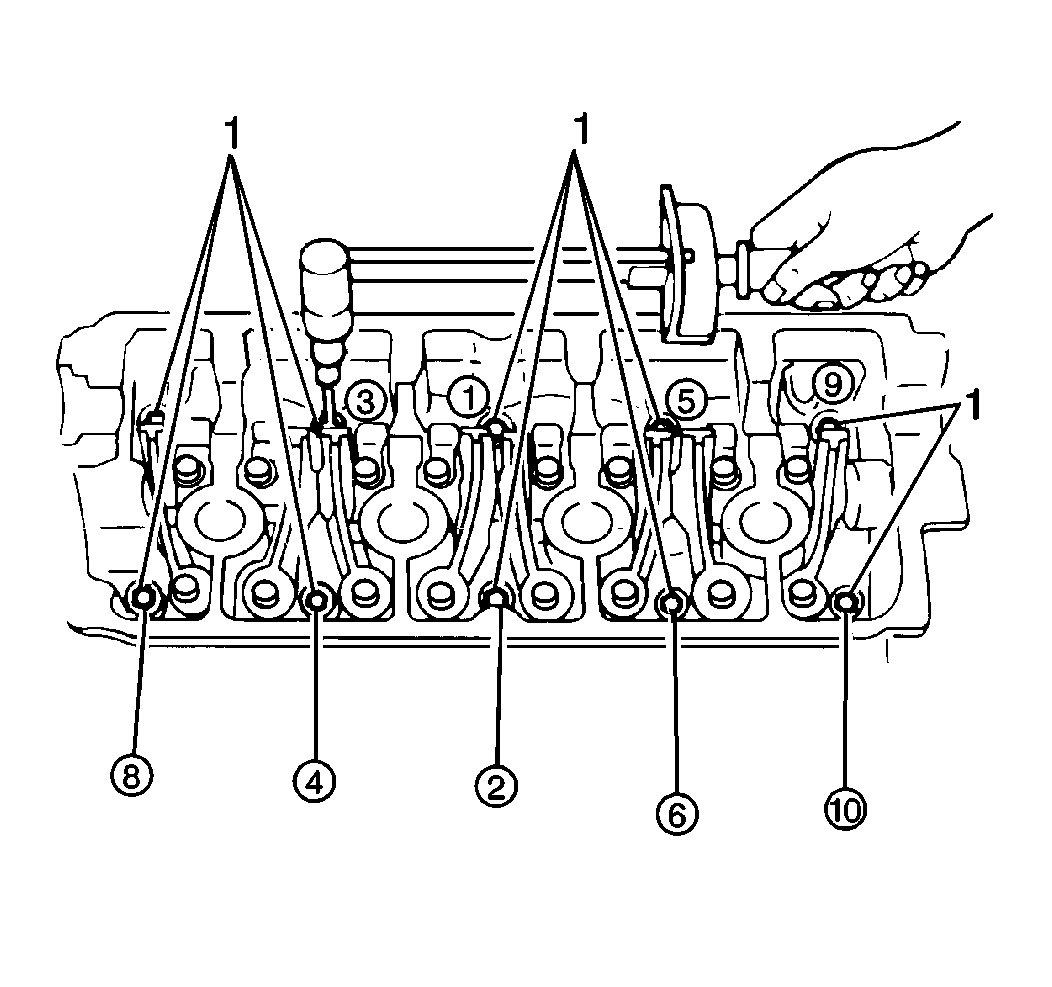
- Install the new cylinder
head gasket to the cylinder block.
- Install the cylinder head, intake manifold, and exhaust manifold
as an assembly onto the cylinder block.
- Secure the cylinder head with ten bolts.
Notice: Use the correct fastener in the correct location. Replacement fasteners
must be the correct part number for that application. Fasteners requiring
replacement or fasteners requiring the use of thread locking compound or sealant
are identified in the service procedure. Do not use paints, lubricants, or
corrosion inhibitors on fasteners or fastener joint surfaces unless specified.
These coatings affect fastener torque and joint clamping force and may damage
the fastener. Use the correct tightening sequence and specifications when
installing fasteners in order to avoid damage to parts and systems.
- Tighten the cylinder
head bolts (1) in 3 separate steps, following the illustrated
sequence.
Tighten
- Tighten the 10 cylinder head bolts on the first pass to
35 N·m (26 lb ft).
- Tighten the 10 cylinder head bolts on the second pass to
55 N·m (41 lb ft).
- Tighten the 10 cylinder head bolts on the final (third)
pass to 70 N·m (52 lb ft).
- After attaining the proper cylinder head torque, the cylinder
head bolts will need to be loosened in the reverse order that they were tightened.
After loosening the cylinder head bolts, retorque the cylinder head
to specifications.
- Tighten the cylinder head bolts (1) in three separate steps, following
the illustrated sequence.
Tighten
- Tighten the ten cylinder head bolts on the first pass to 35 N·m
(26 lb ft).
- Tighten the ten cylinder head bolts on the second pass to 55 N·m
(41 lb ft).
- Tighten the ten cylinder head bolts on the final (third) pass
to 70 N·m (52 lb ft).
- Install the camshaft. Refer to
Camshaft Replacement
.
- Install the timing belt. Refer to
Timing Belt Replacement
.
- Install the valve rocker arm cover. Refer to
Valve Rocker Arm Cover Replacement
.
- Raise and support the vehicle. Refer to
Lifting and Jacking the Vehicle
in General Information.

- Install the front pipe/TWC
assembly (3) with a new gasket (2) to the exhaust manifold (1).
Secure the assembly with 2 bolts.
Tighten
Tighten the exhaust manifold-to-front pipe/TWC assembly bolts to 50 N·m
(37 lb ft).

- Install the exhaust manifold
brackets (1) to the exhaust manifold and the engine block. Secure
the brackets with 1 nut and 2 bolts.
Tighten
| • | Tighten the engine mount-to-exhaust bracket bolts to 54 N·m
(40 lb ft). |
| • | Install the exhaust bracket-to-exhaust manifold nut to 50 N·m
(37 lb ft). |
- Lower the vehicle.
- Connect the (HO2S1) electrical connector.

- Install the crankcase
vent hose (1).
- Install the PCV hose (3) to the PCV valve.
- Connect the fuel injector 6-way connector at the rear of
the intake manifold.

- Install the lower intake
manifold support bracket (2) to the intake manifold (1).
Secure the bracket with 2 bolts.
Tighten
Tighten the lower intake manifold support bracket bolts to 50 N·m
(37 lb ft).

- Install the upper generator
mounting bracket (2). Secure the bracket with 2 bolts.
Tighten
Tighten the upper generator mounting bracket bolts to 50 N·m
(37 lb ft).
- Adjust the generator drive belt tension. Refer to
Drive Belt Replacement
.
- Reinstall the EVAP canister.

- Install the upper radiator
hose to the thermostat housing (1).

- Install the fuel inlet
hose (1) to the fuel line union.
- Install the fuel return hose (2) to the fuel line union.

- Connect the following
electrical connectors:
| • | Exhaust gas recirculation (EGR) connector (4) |
| • | Manifold absolute pressure (MAP) sensor connector (1) |
| • | Engine ground wire (2) from intake manifold |
- Install the Brake booster supply hose (3) to the intake
manifold.

- Connect the following
electrical connectors:
| • | Throttle position (TP) sensor (4) |
| • | Idle air control (IAC) valve (3) |
| • | Engine coolant temperature (ECT) sensor (2) |
| • | Evaporative emission canister purge valve |
- Install the EVAP canister purge valve vacuum hose.
- Install the coolant hose to the throttle body (1).

- Install the accelerator
cable (2) to the accelerator cable bracket (1).
- Install the accelerator cable to the throttle body bellcrank (3).
Adjust the accelerator cable as necessary. Refer to
Accelerator Control Cable Replacement
in Engine Controls.

- Connect the intake air
temperature (IAT) sensor.
- Connect the mass air flow (MAF) sensor.
- Install the electrical harness clamps to the air cleaner assembly.
- Install the air intake hose (7) to the throttle body.
- Refill the cooling system as necessary. Refer to
Cooling System Draining and Filling
in Engine Cooling.
- Install the negative battery cable.
Tighten
Tighten the battery cable bolt to 15 N·m (11 lb ft).

























